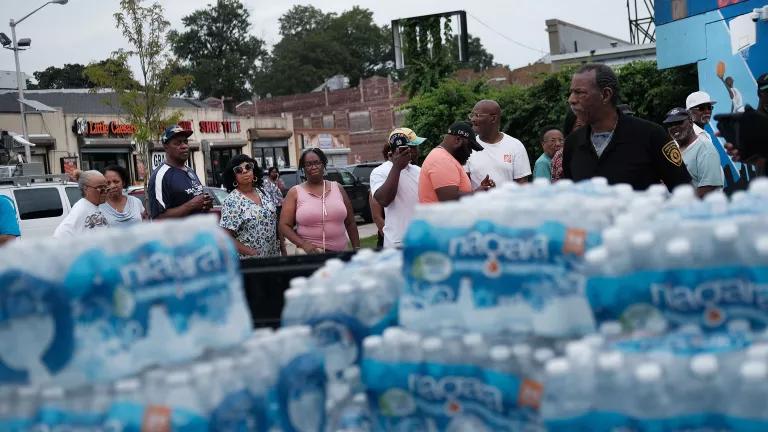EPA Will No Longer Defend Weak Lead in Tap Water Rule in Court
The agency is expected to strengthen health protections by proposing a new rule next year.

Marcelina Pedraza at the home she shares with her daughter Edie, 10, in the East Side neighborhood of Chicago, Illinois. When Marcelina Pedraza had her water tested for lead in January 2020, lead was present in three samples.
Taylor Glascock for NRDC
The agency is expected to strengthen health protections by proposing a new rule next year.
In important and welcome news, the U.S. Environmental Protection Agency (EPA) has announced that it will no longer defend the weak Lead and Copper Rule (LCR) set by the Trump administration. Instead, the agency will propose a new rule by September 2023 and finalize it by October 2024. This comes nearly two years after NRDC, along with partner groups and 10 state attorneys general, challenged the lead regulations, arguing that by leaving millions of people exposed to toxic lead in drinking water, in many cases for another 33 years or more, the EPA’s lead in drinking water rule was inadequate and illegal.
The LCR, issued in 1991, is the agency’s regulation for how to control lead levels in drinking water. For the past three decades, the highly complex rule has failed to ensure that millions of Americans have water that’s free from hazardous lead contamination.
Along with the promise of a new rule, EPA has committed to revisiting the problems that NRDC, frontline groups in communities harmed by lead, health experts, and states have identified with the Trump rule. The agency has committed to conducting a new environmental justice analysis for the rule, and, for the first time, will consider the feasibility of mandating the replacement of 100 percent of the nation’s lead service lines within a specified time. This is an important step forward that we hope will lead to improved drinking water safety for tens of millions of Americans, including millions of young children who are essentially drinking from lead straws every day.
The health of millions of people, especially our kids, is threatened by lead whenever they turn on their taps. Safe drinking water is a basic human right, so EPA must tackle quickly the lead contamination crisis by setting a much stronger lead rule and ensuring that all lead water pipes are pulled out of the ground over the next decade.
From Flint, Michigan to Newark, New Jersey, communities across the country have faced, or are still facing, severe lead-contaminated drinking water crises. Lead service lines — the pipes that carry water from the water main under the street to residences — have long been recognized as the primary contributor of lead in drinking water. NRDC estimates that there is a range of 9.7 million to 12.8 million pipes that are, or may be, lead, spread across all 50 states, including those that claim to have none. And there is no safe level of lead exposure.
As Yvette Jordan, chairperson of the Newark Education Workers (NEW) Caucus in Newark, put it, “No other community in America should ever again have to fight so hard for justice and dignity of drinking water free from lead contamination.”
The EPA’s decision to initiate a new lead regulation, and to take a close look at requiring the replacement of all lead pipes, is in line with President Biden’s commitment to solving the nation’s lead-contaminated drinking water crisis. The president’s approach includes passing historic infrastructure legislation with $15 billion in funding as a down payment towards carrying out his plan to remove 100 percent of lead pipes from the ground within a decade, while prioritizing action in disadvantaged communities.
The previous version of the LCR delayed and, in most cases, refused to require the removal of the millions of lead service lines that remain in use across the country, condemning another generation of children to drinking lead-tainted water.
The Biden administration put the lead in drinking water rule on hold for most of 2021, but in December of that year the EPA announced it would let it take effect, while at the same time acknowledging the rule could be improved and announcing its intent to finalize a new regulation by October 2024. While the so-called Trump rule will remain on the books until that happens, EPA has now made a formal commitment to proposing a new rule by September 2023 and taking a fresh look at many of the lead rule’s shortcomings.




